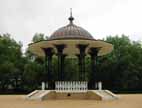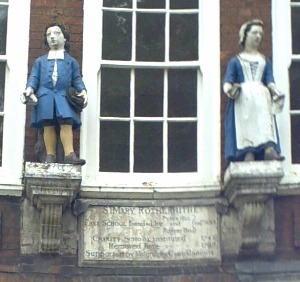
Additional Information
|
ROTHERHITHE & SOUTHWARK PARK Additional Information |
| london-footprints.co.uk |
[church] [police] [pubs] [pump house] [Dr Salter] [school] [Southwark Park] [Thames Path] [tunnels] [wharves]
DR
SALTER 1873-1945
Alfred Salter studied medicine at Guy's Hospital and set up in
practice in Bermondsey in 1900. He and his wife Ada became
involved in local government and politics in an attempt to
improve conditions for the poor of the area. Alfred was elected
to the council in 1903 and became Bermondsey's MP in 1922. Ada
became the first woman counillor in 1910 and Mayor of Bermondsey
in 1922. The area around Wilson Grove was rebuilt in 1928 with
garden-city cottages to their ideas. Dr Salter set up a health
service for Bermondsey 20 years before the National Health
Service. Sadly his 9 year old daughter Joyce died of Scarlet
Fever. The statue group of the family by Diane Gorvin has been
relocated near the Angel Inn (see walk route). The flower garden
in Southwark Park is named after Ada Salter.
|
PUBS The Angel Inn was established in 1682 and rebuilt in the early 19thc. The Ship (left) was built on the opposite side of the street in 1865 but was relocated in 1939, just before the war. The Mayflower (right) built c1550 was originally called the Shippe and later rebuilt as the Spread Eagle & Crown. It was reconstructed after WWII damage and renamed after the pilgrim's vessel. At the time when postage stamps could only be bought at post offices they were also available at this pub. |
|
|
POLICE In 1821 law inforcement was provided by a beadle, a constable and 14 watchmen. Those in white carried lanterns and called the hours and weather but others in blue carried cutlasses and searched dark corners! They operated from the watch house in the churchyard (pictured) from where they could also watch new graves in case of body-snatchers. This building had cells below where wrongdoers could be lodged temporarily. The Metropolitan Police was formed in 1829 and the watch house closed. It was replaced with a police station located in a house of 1814 in Paradise Street by 1836. From the river walk there is a view of the River Police headquarters and boat repair yard in Wapping. |
WHARVES
From Tudor times ships were required to discharge at legal quays
between Billingsgate and the Tower. By the end of the 18thc these
could not cope with the volume of traffic and sufferance wharves
such as Hopes were added to handle lower value
cargoes. Bombay Wharf was used to store flour,
dog food & cereal. Grice's Granary dates
back to 1796-1800 and utilises ship's timber knees in the
interior construction. A gantry walkway links to the riverside
wharf c1859 which was used to store skins and pickles. Tunnel
Wharf dealt with horse skins. Brandham's Wharf
c1870-80 stored paint & vitriol and was converted to flats in
the 1980s. Charles Hay & Co established in
1797 were barge builders and repairers.
 |
PARISH SCHOOL This was founded in 1613 by Peter Hills, a seafarer and Brother of Trinity House, and Robert Bell who both provided money and property. The school, for the education of 8 sons of seamen, was originally at the east end of the church but was demolished in 1795. To replace it the vestry bought Richard Vidlar's house (c1700) in St Marychurch Street which opened in 1797. It later amalgamated with other local charity schools. The figures of the schoolchildren are of Portland Stone. The building was requisitioned for the fire service in WWII, became part of St Mary's Rectory in the 1970s and has now been converted to offices. |
ST
MARY'S CHURCH
At the start of the 18thc the 400 year old church was in a poor
state of repair due to flooding. Two applications to the fund to
'build 50 new churches' were refused so the parish raised money
to which Queen Anne contributed. The new church designed by John
James of Greenwich and influenced by Wren was begun in 1714. The
old tower was demolished in 1746 and replaced in 1748 by a new
one designed by Lancelot Dowbiggin. The church has a barrel roof
supported on wooden columns encased in plaster. Items of
furniture were made from timbers of the Temeraire, a Trafalgar
ship broken up at Rotherhithe in 1838. There are memorials to
Captain Jones, master of the Mayflower and Peter Hills,
co-founder of the parish school. The interior was restyled by
William Butterfield in 1873-6.
THAMES
TUNNEL
Construction of the Thames Tunnel, the first under a major
navigable river, began in 1825. It used a tunnelling shield
designed by Marc Brunel and manufactured by Henry Maudsley.
Brunel's son Isabard Kingdom, as the engineer in charge of
construction, was almost killed when water broke through (see
plaque on site) and the costly project came close to bankrupting
Marc Brunel. Work was suspended between 1828 and 1836 and the
tunnel was finally completed in 1843. An improved shield and
pumping engine had been constructed by John Rennie. The tunnel
was only available to pedestrians as there had been no money to
build the access ramps required for horses. Lit by gas it was
soon lined with stalls but later became rather unsavoury. In 1865
it was adapted to accommodate a railway, a function it retains as
the East London line of the Underground now runs through it. At
Rotherhithe are the remains of the 80' diameter shaft and the
engine house which housed the pumps. This Grade II listed
building of c1842 contains the only surviving compound horizontal
V steam engine built by Rennie and an exhibition
about the construction of the tunnel. It was saved from
demolition in 1973 and opened as a museum in 1980 with a replica
chimney added in 1993.
ROTHERHITHE ROAD TUNNEL
This was designed by Sir Maurice Fitzmaurice in 1904-8 and
renovated in 1979-81. The entrance arches are the cutting edges
of the Greathead tunnelling shield used in its construction. The
4860' foot tunnel necessitated much street widening and 3000
people had to be rehoused.
RENFORTH
PUMP HOUSE
This was built by the London Hydraulic Power Company in 1902-3 to
power warehouse machinery and closed in 1977. It has an prominent
accumulator tower and cast iron settling tanks.
SCANDANAVIAN
CHURCHES
Scananavian ships would be regular visitors to Rotherhithe &
Surrey Docks with their timber cargos. St Olav's Church was
designed by John Seaton Dahl in 1927 to serve sailors and now the
wider Norweigan community. It has a distinctive spire topped with
a model of a Viking ship. The stained glass is by Goddard &
Gibbs of Shoreditch. The church is open to visitors from 12-9pm.
Tel 020 7740 3900 (answered in Norweigan!). The neighbouring Finnish
Church of 1957-9 with a similar social function is by
Yorke Rosenberg & Marshall. This has an attractive bell tower
(best viewed across the street). It opens 1pm Sat & Sun and
3pm Mon- Fri.
SOUTHWARK
PARK
A major programme of restoration work has taken place over the
last few years. The 63 acre park was opened in 1869 on land
previously market gardens & vineyards and purchased from Sir
William Gomm for 56000. It was designed by Alexander McKenzie
for the Metropolitan Board of Works and provided much needed
recreational space with the provision of a cricket ground in
1871, a gymnasium in 1881, football pitches in 1890 and a bowling
green in 1908. The lake was completed in 1885 and adapted for
boating in 1908. This was damaged in WWII and largely filled in
in the 1960s but has now been re-instated. A lido was available
between 1923 and 1985 which is now the site of the children's
playground. A new gallery is open adjacent to this. The bandstand
came from the grounds of the Royal Horticultural Society in
Kensington and was installed in 1884 but was taken away along
with railings during WWII. An exact replica has been built as
part of the restoration (pictured in header). More information on
the park [click here].
THAMES
PATH
A National Trail which follows the Thames for 184 miles from its
source in the Cotswolds to the Thames Barrier. It is signposted
and in London runs along both banks. There is an official guide
book with maps written by David Sharp. website
REFERENCE
SOURCES
London Docklands - an Architectural Guide by Williamson &
Pevsner
Discover Docklands by S K Al Naib
A Trail Walk Around Old Rotherhithe - Time & Talents
publication
london-footprints.co.uk 2006
[route & what to see] [I K Brunel] [walks list]